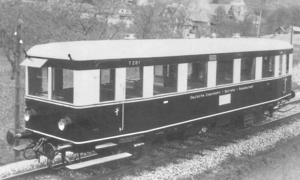Achertalbahn T 281
| Achertalbahn T 281 | |
|---|---|
|
Factory photo
|
|
| Numbering: |
Achertalbahn T 281 WSW VT 4 NH VT 4 |
| Number: | 1 |
| Manufacturer: | Dessau wagon factory |
| Year of construction (s): | 1934 |
| Retirement: | 1971 |
| Axis formula : | AA |
| Gauge : | 1435 mm ( standard gauge ) |
| Length over buffers: | 13,400 mm |
| Total wheelbase: | 7,000 mm |
| Empty mass: | 19,000 kg |
| Service mass: | 23,200 kg |
| Top speed: | 65 km / h |
| Installed capacity: | 2 × 70 kW (2 × 95 PS) |
| Wheel diameter: | 900 mm |
| Motor type: | 2 × Daimler-Benz OM 67 |
| Motor type: | Six-cylinder four-stroke diesel engine |
| Rated speed: | 2,000 rpm |
| Power transmission: | mechanical with Mylius gear |
| Train brake: | Indirect brake , handbrake |
| Seats: | 56 |
| Classes : | 3. |
The Achertalbahn T 281 was a two-axle diesel railcar of the Achertalbahn . It was manufactured in 1935 by the Dessauer Waggonfabrik and was intended to streamline the company's operations. The vehicle was used by three companies. In 1971 the railcar was converted into a sidecar, which is still known today as TA 0304 at Arbeitsgemeinschaft Verkehrsfreunde Lüneburg e. V. exists.
History and commitment
The history of the railcar began in 1935, when it was delivered to the Achertalbahn by the Dessauer Waggonfabrik with the serial number 3099 . The railcar was first named T 281, later it was named VT 4 by DEBG . His use freed a steam locomotive from the company, which could then be handed over to another company. The area of responsibility of the railcar was mixed traffic. In 1940 the vehicle was transferred to the Wiesloch – Meckesheim / Waldangelloch railway line . Another area of application was the Krebsbachtalbahn , between these stations the railcar changed several times in the following years.
In 1963 it was taken over by SWEG . As a sidecar, it was initially continued to be operated by SWEG and, after being converted as a sidecar in 1971, was referred to as VB 4 before Kleinbahn Leeste acquired it in 1989 . Today the sidecar is owned by the Arbeitsgemeinschaft Verkehrsfreunde Lüneburg and is designated as TA 0304 . His NVR number is 95 80 0140 604-9 D-TEL.
Constructive features
The underframe and the box frame were made of lightweight frame construction and consisted of electrically welded structural steel profiles. The outside of the car body was clad with sheet metal 1.5 millimeters thick. The interior was divided into the passenger compartment and the two entry areas with a driver's cab. The passenger compartment consisted of two compartments of roughly the same size with a central aisle, these were divided by partition walls. They were also separated from the entry areas by partition walls and revolving doors. The seats in the 3rd carriage class were made of wood. The floor was made of pine wood covered with linoleum. The machine system could be serviced via flaps in the floor.
The machinery consisted of a six-cylinder four-stroke diesel engine of the type Daimler-Benz OM 67, which was coupled with the Mylius transmission .
literature
- Meinhard Döpner: The Deutsche Eisenbahn Betriebs-Gesellschaft AG . In: Verlag Zeit und Eisenbahn . Lokrundschau Verlag GmbH, Gülzow 2002, ISBN 3-931647-13-7 .
- Gerd Wolff, Hans-Dieter Menges: German small and private railways. Volume 2: Bathing . EK-Verlag, Freiburg 1992, ISBN 3-88255-653-6 , p. 300-308 .
Web links
- Website about the TA 0304 passenger car of the Heide-Express , created in 1971 from the AO VT 4
- Photo of the T 281 on the Krebsbachtalbahn, taken in 1962 by the Joachim Schmidt Railway Foundation
- Photo of the T 281 on the Krebsbachtalbahn in freight train service, taken in 1964 by the Joachim Schmidt Railway Foundation
- Photo of the T 281 in Neckarbischofsheim, taken in 1964 by the Joachim Schmidt Railway Foundation
Individual evidence
- ↑ Meinhard Doepner: The German railway operating company AG . In: Verlag Zeit und Eisenbahn . Lokrundschau Verlag GmbH, Gülzow 2002, ISBN 3-931647-13-7 , p. 151 .
- ^ Gerd Wolff, Hans-Dieter Menges: German small and private railways . tape 2 : bathing. EK-Verlag, Freiburg 1992, ISBN 3-88255-653-6 , p. 308 .
- ↑ Website about the history of the former AO VT4 on the Heide-Express
